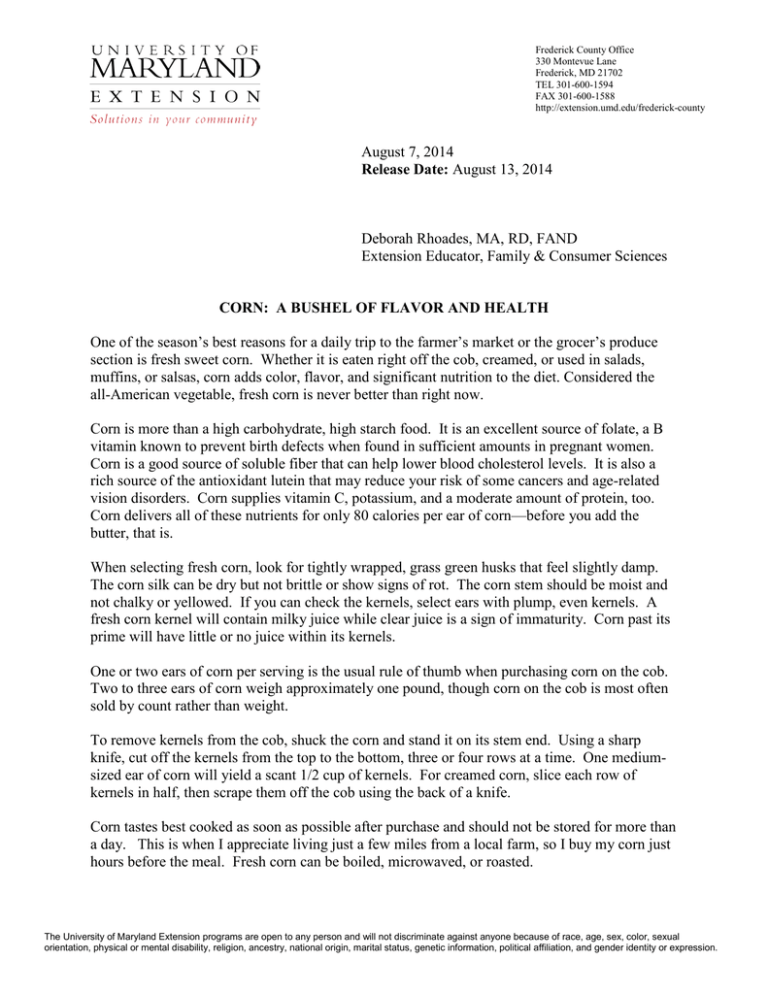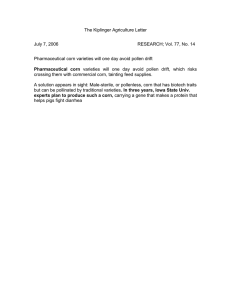
Frederick County Office
330 Montevue Lane
Frederick, MD 21702
TEL 301-600-1594
FAX 301-600-1588
http://extension.umd.edu/frederick-county
August 7, 2014
Release Date: August 13, 2014
Deborah Rhoades, MA, RD, FAND
Extension Educator, Family & Consumer Sciences
CORN: A BUSHEL OF FLAVOR AND HEALTH
One of the season’s best reasons for a daily trip to the farmer’s market or the grocer’s produce
section is fresh sweet corn. Whether it is eaten right off the cob, creamed, or used in salads,
muffins, or salsas, corn adds color, flavor, and significant nutrition to the diet. Considered the
all-American vegetable, fresh corn is never better than right now.
Corn is more than a high carbohydrate, high starch food. It is an excellent source of folate, a B
vitamin known to prevent birth defects when found in sufficient amounts in pregnant women.
Corn is a good source of soluble fiber that can help lower blood cholesterol levels. It is also a
rich source of the antioxidant lutein that may reduce your risk of some cancers and age-related
vision disorders. Corn supplies vitamin C, potassium, and a moderate amount of protein, too.
Corn delivers all of these nutrients for only 80 calories per ear of corn—before you add the
butter, that is.
When selecting fresh corn, look for tightly wrapped, grass green husks that feel slightly damp.
The corn silk can be dry but not brittle or show signs of rot. The corn stem should be moist and
not chalky or yellowed. If you can check the kernels, select ears with plump, even kernels. A
fresh corn kernel will contain milky juice while clear juice is a sign of immaturity. Corn past its
prime will have little or no juice within its kernels.
One or two ears of corn per serving is the usual rule of thumb when purchasing corn on the cob.
Two to three ears of corn weigh approximately one pound, though corn on the cob is most often
sold by count rather than weight.
To remove kernels from the cob, shuck the corn and stand it on its stem end. Using a sharp
knife, cut off the kernels from the top to the bottom, three or four rows at a time. One mediumsized ear of corn will yield a scant 1/2 cup of kernels. For creamed corn, slice each row of
kernels in half, then scrape them off the cob using the back of a knife.
Corn tastes best cooked as soon as possible after purchase and should not be stored for more than
a day. This is when I appreciate living just a few miles from a local farm, so I buy my corn just
hours before the meal. Fresh corn can be boiled, microwaved, or roasted.
The University of Maryland Extension programs are open to any person and will not discriminate against anyone because of race, age, sex, color, sexual
orientation, physical or mental disability, religion, ancestry, national origin, marital status, genetic information, political affiliation, and gender identity or expression.
When boiling, shuck the corn only moments before cooking. Do not add salt to the cooking
water as this will toughen the kernels. Simply drop the shucked corn into boiling water and
continue boiling for 3 to 5 minutes.
To roast corn, you must remove the corn silk but retain the husks. Pull the husks down, one by
one, to the stem end, keeping the husks attached. Remove all corn silk and rewrap the corn with
the husks. Tie it at the top with string. Soak the corn in cold water for at least 10 minutes to
prevent burning. Roast over hot coals, turning frequently, for 15 to 30 minutes, depending on the
size of the corn.
To microwave, Place on paper towel and cook on high temperature with husks and silks intact.
Turn ears over and rearrange during 1/2 cooking time. Cooking times based on number of ears
in microwave:
1 ear (1 1/2 minutes)
2 ears (3 to 4 minutes)
3 ears (5 to 6 minutes
4 ears (7 to 8 minutes)
5 ears (8 to 9 minutes)
Corn purists believe that a fresh ear of cooked corn needs nothing more than butter or margarine,
salt and pepper. It does, however, lend itself to a variety of seasonings. Try basil, chili powder,
chive, cumin, curry powder, lime, mint, sage, or thyme. Topping a hot ear of corn with herbed or
spiced margarine is also a delicious and different way to enjoy this summer treat.
For those of you who want to enjoy fresh corn off the cob, here are a few recipes that showcase
this golden summer vegetable. While in the kitchen consider freezing some kernels to enjoy year
round. The National Center for Home Food Preservation provides directions at
http://nchfp.uga.edu/how/freeze/corn.html
FRESH CORN SALAD
Serves 4 to 6
5 ears of fresh corn, shucked (do not substitute frozen or canned corn)
1/2 cup diced red onion
3 tablespoons cider vinegar
3 tablespoons olive oil
1/2 teaspoon salt
1/2 teaspoon ground black pepper
1/2 cup thinly sliced fresh basil leaves
In a large pot of boiling water, cook the corn for 3 minutes. Drain and immerse it in ice water to
stop the cooking and set the color. Allow the corn to cool. Cut the corn kernels off the cob,
cutting close to the cob. In a large bowl, toss the kernels with the red onions, vinegar, olive oil,
salt, and pepper. Just before serving, add the fresh basil and toss again. Serve cold or at room
temperature.
RANCH CORN SALAD
6 servings
2 cups corn – fresh or frozen, cooked and drained
2 medium tomatoes, peeled and chopped
1/2 green pepper, chopped
1/4 onion, chopped
1/4 cup low-fat ranch dressing
Prepare vegetables and combine in bowl. Stir in salad dressing. Cover and refrigerate until
ready to serve.
CHEESE AND CORN CHOWDER
Serves 6 – 1 cup servings
2 potatoes, peeled and cubed
3 medium carrots, peeled and sliced
3 celery stalks, chopped
1/2 onion, chopped
6 medium ears of fresh corn, shucked and removed from the cob
1/4 teaspoon pepper
1 1/2 cup low fat milk
1/2 cup shredded cheddar cheese
Combine potatoes, carrots, celery and onion in pan. Add 1 cup water, cover and simmer for 10
minutes. Add fresh corn and pepper. Cook 5 more minutes or until vegetables are soft. Add
milk and cheese. Stir until cheese melts and chowder is heated through. Do not boil.
Note: 2 cups of frozen corn OR can (15 oz.) cream-style corn can be substituted for fresh corn
For more information about the University of Maryland Extension Frederick County Office
check out our website http://extension.umd.edu/frederick-county
University of Maryland Extension programs are open to all persons and will not discriminate
against anyone because of race, age, sex, color, sexual orientation, physical or mental disability,
religion, ancestry, or national origin, marital status, genetic information, or political affiliation, or
gender identity and expression.
Deborah Rhoades, MA, RD, FAND, is a licensed Registered Dietitian, Fellow of the Academy
of Nutrition Dietetics, and Extension Educator in Family and Consumer Sciences.
DHR:ls






